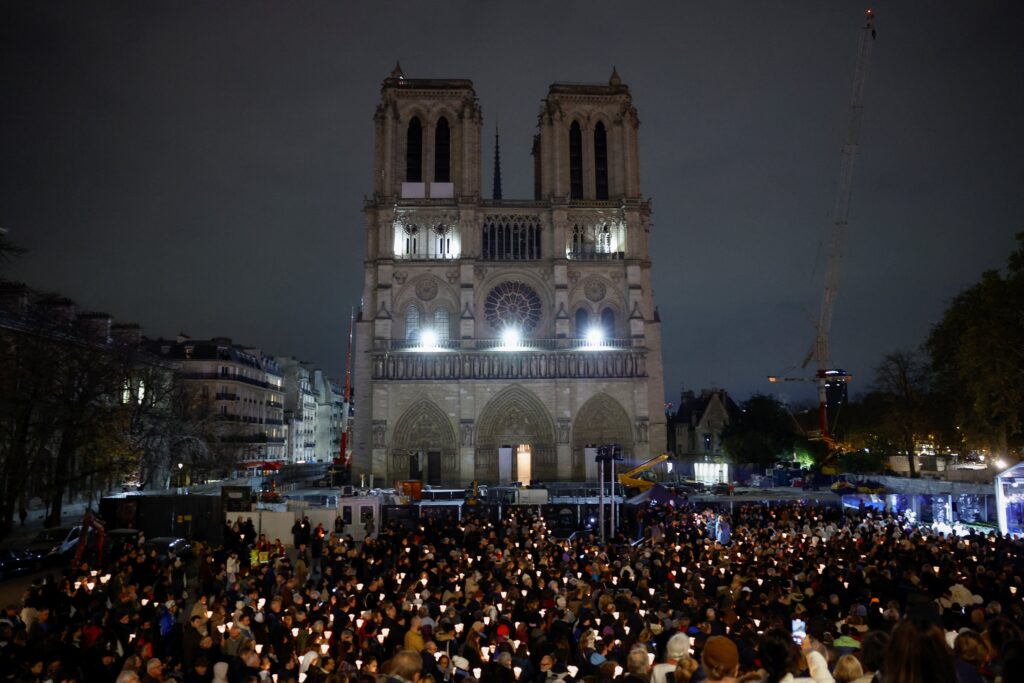
Americans React to Notre Dame's December 8 Reopening
By: Our Sunday Visitor
“New Yorkers, like people all over the world, were stunned and saddened watching Notre Dame Cathedral in flames, even as we were inspired by the faith of the people of France that their iconic cathedral would soon be restored,” Cardinal Dolan told OSV News

(OSV News) — The devastating images — whether viewed from the banks of the Seine River in Paris or on millions of glowing screens around the world — stunned onlookers. Many wept, clutching tissues to smoke- and sorrow-reddened eyes, others prayed aloud or in silence, and some even sang hymns.
It was the evening of April 15, 2019, and Notre Dame Cathedral — an 850-plus-year-old, stone-and-mortar monument to human ingenuity and religious aspiration — was burning.
France is a famously secular nation. Once known as “the eldest daughter of the church,” slightly less than half of the population call themselves Catholics and only about five percent of the total population attend weekly Mass.
But on that slightly chilly spring evening, such statistics didn’t matter. A thing of beauty was being destroyed — and it wasn’t required to be religious, or even Catholic, to mourn its possible extinction.
“Paris without Notre Dame … madness,” one onlooker mused to CNN as it broadcast the conflagration. Experts later estimated the heat in the cathedral’s crossing reached as high as 2,200 degrees Fahrenheit, hot enough to melt metal.
Now, five years later — owing to the courage of Paris’ firefighters, nearly $1 billion from worldwide donors, and the skills of almost 1,000 artisans — Notre Dame is scheduled to reopen to the public December 7-8.
OSV News talked to some friends and admirers of the cathedral to ask what Notre Dame’s phoenix-like resurrection means to them and Americans.
“When the fire happened at Notre Dame, it cut me so deep as I watched it in real-time,” said Ron St. Angelo, a photographer who documented the cathedral during repairs. “Because Notre Dame — even though it wasn’t built for that exact purpose — has become the symbol worldwide for the Mother Of God, Our Lady. Notre Dame housed relics and artifacts from the Crucifixion, including the crown of thorns.”
St. Angelo is the official photographer of the Dallas Cowboys and also shoots for the Diocese of Dallas. For this assignment, St. Angelo lodged at a hotel within walking distance from Notre Dame — and on the cold rainy day when he first saw it after the fire, he had the impression tears were being shed.
Thinking back to the day it burned, “It felt like we were watching something that I would compare to seeing the Crucifixion. That’s what it felt like,” St. Angelo recalled. “Something so iconic and so symbolic was being destroyed. … I said, ‘They’ll never be able to restore this.'”
Circling the cathedral with his camera, however, St. Angelo became more optimistic.
“I started seeing all of the reconstruction and scaffolding and everything — and I thought, ‘They’re bound and determined to recreate this,'” he said. “So, in a way, it was akin to the Resurrection — because it was brought back to life.”
Among those entrusted with that task was Jennifer Feltman, an associate professor of art history at the University of Alabama who specializes in medieval art. She is a member of the “Chantier scientifique de Notre Dame” working group organized by the French government to play a role in the cathedral’s preservation.
“The first time I visited the site after the 2019 fire was with my colleagues in September of 2021,” Feltman said. “COVID travel bans had just been lifted for the USA to France, but we were all still amid the global pandemic and it very much felt that way.”
Arriving in the City of Light, Feltman was immediately struck by a noticeable absence.
“When I saw the Paris skyline without the spire of Notre Dame, it was deeply sad. At the same time, it felt hopeful to see the energy of the workers and to meet researchers involved in the restoration, with whom I have been working,” she said. “There is a great sense of pride among all and a collective energy of being part of something much bigger than us.”
Feltman believes the reopening will represent a significant shift.
“On December 7, the keys will be handed back to the church. A choir of workers and researchers will sing, and I think for them, this will be a key moment of transition from this being a worksite to becoming again a site for the faithful,” she said.
The river of funding that flowed to Notre Dame after the catastrophe perhaps defied expectations — or not, given the apparently universal affection for the cathedral.
“There is a very strong attachment — and even love — of American people for Notre Dame,” affirmed Michel Picaud, president of the Friends of Notre Dame de Paris, a nonprofit organization launched in 2017 dedicated to raising restoration funds for the cathedral.
Its age and history, the lengthy alliance between the U.S. and France, cultural references such as books and musicals — all play a role in that relationship and the popular imagination, Picaud said.
“They consider that Notre Dame de Paris is not only a French cathedral, or a Roman Catholic cathedral — but it’s also part of the universal heritage,” he said. “People consider that this is part of their own culture, if you will.”
Although the fire was not a terrorist act, Picaud also sees an eerie similarity between the horrors Americans witnessed on Sept. 11, 2001 and the Notre Dame disaster.
“When the fire happened, I think the fall of the spire of the cathedral reminded people of September 11,” he suggested. “And so, it was even more of a shock.”
Cardinal Timothy M. Dolan of New York, who has accepted the invitation of Paris’ Archbishop Laurent Ulrich to attend Notre Dame’s December 8 rededication, confirmed that residents of the Big Apple were indeed jolted.
“New Yorkers, like people all over the world, were stunned and saddened watching Notre Dame Cathedral in flames, even as we were inspired by the faith of the people of France that their iconic cathedral would soon be restored,” Cardinal Dolan told OSV News. “As I stood in front of our own beloved St. Patrick’s Cathedral that day, I expressed our hope and prayers that this magnificent monument of the faith of the French people be rebuilt.”
Located in Midtown Manhattan and known as “America’s Parish Church,” St. Patrick’s Cathedral established a “St. Patrick’s to Notre Dame” fund to contribute to the rebuilding effort.
The Basilica of the National Shrine of the Immaculate Conception in Washington — the largest Roman Catholic Church in North America — also aided the effort, said Monsignor. Walter Rossi, the shrine’s rector.
The shrine “established a special online collection to facilitate donations to support the restoration of the iconic cathedral, which, thanks to the generosity of American Catholics, raised $563,794,” he said. “It is wonderful that five years later, Notre Dame will reopen on the solemnity of the Immaculate Conception for the world to once again enjoy the beauty, peace, and magnificence of this iconic shrine in honor of Our Lady.”
Vanessa Corcoran, a medieval scholar and advising dean in the College of Arts and Sciences at Georgetown University in Washington, said collaboration made that outcome a reality.
“Notre Dame took almost two centuries to build in the first place. In a world that’s so filled with division right now, the desire to unite across different disciplines and interests to save Notre Dame — and to restore it to its glory — is an amazing thing,” she said. “When they talk about the restoration process, you have scientists who are weighing in, you have art historians weighing in, environmentalists — and all bringing in each of their unique fields of expertise to make this happen. It’s uplifting to see that sort of collaboration.”
Ultimately, the work of all those who resurrected the cathedral serves the highest purpose.
“The reopening of Notre Dame in Paris once again allows for a unique encounter with the Divine,” said Father Edward Looney, secretary of the Mariological Society of America. “Many seek out the cathedral for its history and beauty, while at the same time, they come in contact with the Lord, his mother, and the saints. A visit offers a person grace — whether they realize it or not.”
– – –
Kimberley Heatherington writes for OSV News from Virginia.

